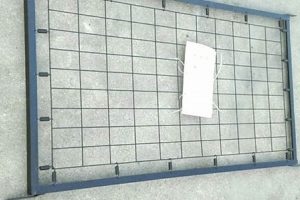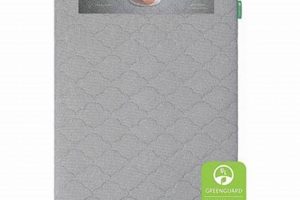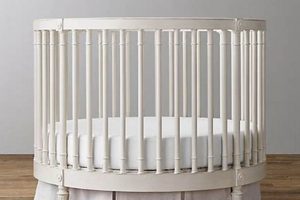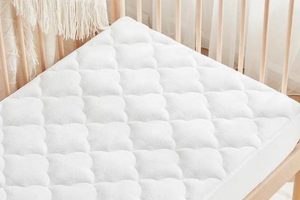The dimensions of a crib mattress and a twin mattress represent a significant difference in sleep surface area. A standard crib mattress is designed for infants and toddlers, adhering to specific safety regulations regarding its size and firmness. Conversely, a twin mattress is intended for older children, teenagers, and even adults, offering a larger space to accommodate growth and movement during sleep. For instance, a common crib mattress measures approximately 28 inches wide and 52 inches long, while a standard twin mattress is around 38 inches wide and 75 inches long.
Understanding these dimensional distinctions is crucial for ensuring appropriate sleep environments at various developmental stages. Utilizing a correctly sized mattress promotes safety, comfort, and adequate rest. Historically, the progression from crib to larger bed sizes marks a key transition in a child’s development, signifying increased independence and physical maturity. Choosing the right mattress size impacts not only sleep quality but also the long-term health and well-being of the individual.
The following sections will delve into the specific measurements of each mattress type, examine factors influencing the decision to transition between them, and provide guidance on selecting the optimal bedding and accessories for each size. This analysis aims to provide a comprehensive understanding of the considerations involved when choosing between smaller and larger sleep surfaces.
Guidance on Mattress Size Selection
Selecting the appropriate mattress size for a child’s developmental stage requires careful consideration of safety, comfort, and space constraints. The following tips offer practical guidance to aid in this decision-making process.
Tip 1: Prioritize Safety Standards. Crib mattresses must adhere to strict safety regulations regarding size and firmness to minimize the risk of suffocation and entrapment. Ensure that any crib mattress considered meets or exceeds these standards.
Tip 2: Consider Room Dimensions. Evaluate the available space in the bedroom before deciding on a mattress size. A twin mattress requires significantly more floor area than a crib mattress, which may impact room functionality.
Tip 3: Assess Child’s Developmental Readiness. The transition from a crib to a twin bed should be based on a child’s physical maturity and emotional readiness. Premature transitions can lead to sleep disruptions and safety concerns.
Tip 4: Factor in Long-Term Use. While a crib mattress is suitable only for infants and toddlers, a twin mattress can accommodate a child through adolescence and into adulthood. This long-term utility can offset the initial cost difference.
Tip 5: Evaluate Mattress Firmness. The optimal firmness level differs between crib and twin mattresses. Crib mattresses must be firm to reduce the risk of SIDS, while twin mattresses can offer a range of firmness options based on individual preferences.
Tip 6: Research Material Composition. Consider the materials used in the construction of both crib and twin mattresses. Opt for hypoallergenic and non-toxic materials to promote a healthy sleep environment.
Tip 7: Budget for Bedding and Accessories. Remember to factor in the cost of bedding, such as sheets, blankets, and pillows, when budgeting for a new mattress. These costs can vary significantly between crib and twin sizes.
Careful consideration of these factors will contribute to an informed decision when choosing between a smaller and larger sleep surface, ultimately promoting restful sleep and safe sleep practices.
The next section will address specific considerations for families with limited space, offering creative solutions for maximizing functionality without compromising on safety or comfort.
1. Surface Area
The surface area of a mattress is a primary differentiator between crib and twin mattress sizes. This attribute directly correlates with the sleeping space available and impacts comfort, safety, and suitability for different age groups. The limited surface area of a crib mattress, typically around 1456 square inches (28 inches x 52 inches), is designed to contain infants and toddlers, minimizing the risk of falls or entrapment. This restricted area provides a secure environment for early development stages. Conversely, the considerably larger surface area of a twin mattress, roughly 2850 square inches (38 inches x 75 inches), offers greater freedom of movement for older children, teenagers, and adults. This increased space accommodates growth spurts and allows for more comfortable sleep positions.
The implications of surface area extend beyond mere dimensions. Consider a child transitioning from a crib to a twin bed: the increased surface area demands appropriate bedding to maintain safety and prevent entanglement. Furthermore, the larger area allows for greater heat dissipation, which can impact sleep quality, especially in warmer climates. The difference in surface area also influences the type of sleep accessories used. For example, a weighted blanket designed for a twin bed would be unsuitable and potentially unsafe for use on a crib mattress. In essence, surface area dictates the overall usability and functionality of each mattress type, directly impacting the sleep experience.
Understanding the surface area differences is crucial for selecting the optimal mattress. This dimension governs movement, safety, and thermal regulation. Choosing a mattress inappropriate for the intended user can compromise comfort, safety, and sleep quality. While crib mattresses prioritize secure confinement, twin mattresses prioritize expansive comfort. The discrepancy in surface area should inform all decisions related to bedding, accessories, and overall sleep environment configuration. A correct match is therefore vital.
2. Length Dimensions
The length dimension is a critical aspect differentiating a crib mattress and a twin mattress. The shorter length of a crib mattress, typically around 52 inches, is intentionally designed to fit within the confines of a crib structure, providing a safe and contained sleeping environment for infants and young toddlers. This shorter length limits the mobility of a small child, preventing falls and ensuring the child remains within the caregiver’s field of vision. The length dimension is cause for transitioning the child out of the crib, as they surpass the physical limit of the crib, this directly affects the length dimension of the mattress. Conversely, the extended length of a twin mattress, approximately 75 inches, accommodates older children, teenagers, and adults, who require additional space to stretch and move comfortably during sleep. This increase in length is a direct response to the physical growth and developmental needs of individuals beyond the infant and toddler stages.
Consider a practical example: a child reaching a height of 36 inches will likely be comfortable in a crib, as there is sufficient space within the 52-inch length of the crib mattress. However, a child nearing 48 inches in height will experience increasing discomfort and restricted movement within the same crib. This discomfort indicates a need to transition to a twin bed. Furthermore, the length dimension is critical when selecting bedding. Crib sheets, designed for the 52-inch length, would not fit a twin mattress, which requires sheets designed for a 75-inch length. Incorrect bedding can create safety hazards, such as loose fabric that could pose a suffocation risk. Therefore, understanding the precise length dimensions is vital for ensuring both safety and comfort.
In summary, the length dimension is a defining characteristic that separates crib and twin mattresses, serving distinct purposes dictated by developmental stage and physical size. Challenges arise when delaying the transition to a twin bed, as it can result in compromised sleep quality and potential safety risks. The length dimension is not merely a measurement, but a crucial component in the overall functionality and suitability of a mattress, directly impacting the user’s safety, comfort, and sleep experience.
3. Width Differences
The width discrepancy between a crib mattress and a twin mattress constitutes a significant dimensional difference impacting sleep comfort and functionality. A standard crib mattress typically measures around 28 inches in width, a dimension designed to provide a snug and secure environment for infants. This limited width is intended to prevent infants from rolling excessively, minimizing the risk of suffocation or entanglement within the crib environment. Conversely, a standard twin mattress measures approximately 38 inches wide, offering a substantial increase in horizontal space. This added width caters to the needs of older children, adolescents, and adults, allowing for greater freedom of movement during sleep and accommodating diverse sleep positions. The ten-inch difference in width directly influences the user’s ability to stretch out, turn over, and maintain a comfortable sleeping posture throughout the night. For instance, a child who frequently changes positions during sleep may find the confines of a crib mattress restrictive, leading to restless sleep and potential disturbances. This necessitates a transition to a wider twin mattress to accommodate their natural sleep patterns.
The practical implications of width differences extend beyond mere comfort. The additional width of a twin mattress allows for the accommodation of larger bedding accessories, such as thicker blankets and pillows, without compromising the user’s sleep space. Moreover, the increased width provides a greater buffer zone, reducing the likelihood of rolling off the mattress during sleep, particularly for individuals prone to tossing and turning. Consider a scenario where a child shares a bedroom with a sibling; the greater width of a twin mattress can provide a sense of personal space and minimize disturbances caused by movements during the night. This aspect is crucial for promoting restful sleep and fostering a positive sleep environment. Bedding manufacturers recognize the importance of width differences and design accessories accordingly, ensuring that sheets, comforters, and mattress protectors are appropriately sized to fit each mattress type. This tailored approach to bedding design reflects the understanding that width significantly impacts overall sleep quality and usability.
In summary, the disparity in width between crib and twin mattresses is a critical consideration when selecting appropriate sleep surfaces. The limited width of a crib mattress prioritizes safety and containment for infants, while the greater width of a twin mattress caters to the comfort and movement needs of older individuals. Challenges may arise if a child outgrows the width of a crib mattress prematurely, leading to discomfort and restlessness. Careful attention to width dimensions, alongside length considerations, is essential for ensuring optimal sleep quality, safety, and overall user satisfaction. The width differences is not a mere metric, but a defining characteristic that shapes the sleep experience.
4. Height Variability
Height variability, while often overlooked, is a subtle yet important factor when comparing crib and twin mattresses. This dimension affects the overall profile of the sleep surface and can impact ease of access, compatibility with bedding, and perceived comfort. The variations in mattress height, though generally smaller than length or width differences, contribute to the distinct characteristics of each mattress type.
- Edge Support and Safety
The height of a mattress, particularly in the context of edge support, influences safety. A taller mattress in either crib or twin size may exhibit varying degrees of edge support, affecting the stability of individuals as they get in and out of bed. In a crib, lower-profile mattresses are often preferred to minimize the risk of a child climbing out, while in twin beds, edge support can prevent roll-off during sleep. Height variability directly affects a mattress’s structural integrity and safety for all users.
- Bed Frame Compatibility
Mattress height must be compatible with the chosen bed frame. A crib mattress is designed to fit snugly within a crib frame, with minimal gaps to prevent entrapment. The height of the mattress should not exceed the recommended safety guidelines for crib rails. Twin mattresses, on the other hand, can be used with various bed frames, including platform beds, box springs, and adjustable bases. The height of the mattress impacts the overall bed height and the accessibility for the user. The difference in height may also necessitate the use of specific types of bedding and accessories, such as deeper-pocketed sheets, to ensure a proper fit.
- Impact on Accessibility
The height of a mattress influences how easily a child or adult can get in and out of bed. A lower-profile crib mattress allows caregivers easy access to the infant. A twin mattress that is too high, especially when combined with a tall bed frame, can pose a challenge for younger children. Selecting an appropriate mattress height ensures ease of use and promotes independence.
- Influence on Aesthetics
While functionality is paramount, mattress height also contributes to the overall aesthetic of the bedroom. A thinner crib mattress can create a streamlined look, while a thicker twin mattress can add a sense of luxury and comfort. The visual impact of mattress height should be considered in the context of the room’s decor and personal preferences.
In conclusion, height variability is a subtle dimension. The choice between the different thicknesses can affects various aspects of the sleep experience. From safety to accessibility and compatibility with bedding and bed frames, height variability plays a role in determining overall satisfaction with a mattress. When comparing the size of a crib mattress and a twin mattress, it is important to carefully consider not only the length and width but also the height to ensure a safe, comfortable, and functional sleep environment.
5. Sleeping Space
The available sleeping space, directly dictated by the dimensions of the mattress, is a core consideration when evaluating a crib mattress versus a twin mattress. A crib mattress, constrained by its regulated size, provides a compact sleeping area appropriate for infants and small toddlers. This limited space promotes a sense of security and prevents excessive movement that could pose a safety risk. Transitioning to a twin mattress introduces a significantly larger sleeping surface, accommodating the growth and increased mobility of older children and adults. The cause-and-effect relationship is clear: insufficient sleeping space leads to discomfort, restlessness, and potentially disrupted sleep patterns. Real-world examples include a toddler attempting to stretch out on a crib mattress and frequently bumping against the sides, or a teenager struggling to find a comfortable sleeping position on the same surface. The importance of adequate sleeping space is paramount for restorative sleep.
Practical significance stems from recognizing the developmental stages and physical needs of the individual using the mattress. As a child grows, the restricted space of a crib becomes inadequate, hindering their ability to move freely and hindering optimal sleep quality. A twin mattress offers the necessary room to accommodate growth spurts, varied sleep positions, and personal preferences. For instance, a child who enjoys sleeping on their stomach with arms outstretched would find the confines of a crib mattress severely limiting. The provision of adequate sleeping space directly impacts physical comfort, sleep efficiency, and overall well-being. Ignoring the need for more sleeping space can lead to compromised sleep quality, impacting cognitive function, mood regulation, and physical health.
In summary, the available sleeping space is intrinsically linked to mattress dimensions and dictates the suitability of a crib mattress versus a twin mattress for various developmental stages. Prioritizing appropriate sleeping space ensures comfort, safety, and optimal sleep quality. Challenges arise when delaying the transition to a larger mattress, potentially impacting physical and cognitive development. Understanding this connection is crucial for making informed decisions about mattress selection, fostering a sleep environment that supports health and well-being throughout life.
6. Weight Capacity
Weight capacity is a fundamental, though often overlooked, specification that distinguishes a crib mattress from a twin mattress. It reflects the mattress’s structural integrity and its ability to support weight without compromising safety or comfort. Understanding weight capacity is crucial in selecting an appropriate mattress, as exceeding these limits can lead to premature wear, sagging, or even complete structural failure. It is also important to not how weight capacity differs across the size of crib mattress vs twin mattress due to safety regulations.
- Structural Design and Materials
The materials and construction methods employed in manufacturing crib and twin mattresses directly influence their respective weight capacities. Crib mattresses, designed for infants, typically feature a core of high-density foam or innerspring coils engineered to support the relatively low weight of a baby. The structural design prioritizes firmness and support to minimize the risk of Sudden Infant Death Syndrome (SIDS). Twin mattresses, intended for older children and adults, utilize more robust materials and construction techniques to accommodate higher weight loads. The core may consist of thicker innerspring coils, denser foam layers, or a combination thereof. The weight capacity of a twin mattress is significantly higher, often exceeding 200 pounds, reflecting the broader range of potential users.
- Safety Standards and Regulations
Weight capacity plays a critical role in adhering to safety standards and regulations for crib mattresses. Regulatory bodies, such as the Consumer Product Safety Commission (CPSC), establish guidelines for crib mattress construction to ensure the safety of infants. These guidelines often stipulate minimum requirements for weight capacity, firmness, and overall structural integrity. Compliance with these standards is essential to minimize the risk of injury or death. Twin mattresses, while not subject to the same stringent regulations as crib mattresses, must still meet industry standards for safety and durability. Manufacturers typically provide weight capacity information to guide consumers in selecting an appropriate mattress.
- Impact on Mattress Longevity
Exceeding the recommended weight capacity of a mattress, whether crib or twin size, can significantly reduce its lifespan. Over time, excessive weight can cause the mattress to sag, lose its shape, and develop indentations. This degradation compromises the mattress’s ability to provide adequate support and comfort, potentially leading to back pain, discomfort, and disrupted sleep. Regular inspection for signs of wear and tear, such as sagging or indentations, is essential. Following the manufacturer’s recommendations regarding weight capacity can help prolong the life of the mattress and ensure continued comfort and support. For a crib mattress vs twin mattress, knowing weight limits allow for the correct use for the desired needs.
- Suitability for Shared Sleep Environments
In some situations, a twin mattress may be used in a shared sleep environment, such as when a parent sleeps with a young child. In these cases, it is crucial to consider the combined weight of all occupants to ensure that the mattress’s weight capacity is not exceeded. Exceeding the weight limit can compromise the mattress’s structural integrity and safety, potentially leading to discomfort or injury. If a shared sleep environment is anticipated, it may be necessary to select a twin mattress with a higher weight capacity to accommodate the additional load. It is generally unsafe to use a crib mattress for shared sleep, as its small size and limited weight capacity are not designed to accommodate more than one individual.
The interplay between weight capacity and size is paramount when choosing between a crib mattress and a twin mattress. While the dimensions dictate the physical space available, the weight capacity ensures that the chosen sleep surface can safely and comfortably support the intended user or users. Understanding the structural design, safety standards, and potential impact on longevity is essential for making an informed decision that promotes both safety and restful sleep. A correct understanding across the size of crib mattress vs twin mattress can guide in the choice process.
7. Age Appropriateness
The correlation between age appropriateness and mattress size is fundamental to ensuring a safe and developmentally suitable sleep environment. The dimensions of a crib mattress are explicitly designed for infants and toddlers, reflecting their physical size, motor skills, and safety requirements. The cause-and-effect relationship is clear: using an inappropriately sized mattress can lead to safety hazards and compromised sleep quality. For instance, placing an older child in a crib, long after they have outgrown its dimensions, restricts their movement, potentially causing discomfort and sleep disturbances. The dimensions of a twin mattress, on the other hand, cater to the needs of older children, adolescents, and adults, offering increased space to accommodate growth and movement. Selecting a mattress size that aligns with the user’s age and developmental stage is crucial for promoting restful sleep and minimizing potential risks.
The importance of age appropriateness in the context of mattress selection extends beyond mere physical comfort. Consider a scenario where a toddler, capable of climbing, is confined to a crib long after they have surpassed its recommended height limit. This situation presents a significant safety risk, as the child may attempt to climb out of the crib, potentially resulting in falls and injuries. The practical significance of understanding this connection lies in recognizing that mattress size is not simply a matter of preference, but a determinant of safety and well-being. Healthcare professionals and child development experts recommend transitioning from a crib to a larger bed when a child reaches a certain height or demonstrates the ability to climb out of the crib. This transition is a critical step in ensuring a safe and developmentally appropriate sleep environment.
In summary, the dimensions of a crib mattress and a twin mattress are directly linked to age appropriateness, serving distinct purposes aligned with different developmental stages. Challenges arise when age-related factors are disregarded, potentially leading to safety hazards and compromised sleep quality. Prioritizing age appropriateness in mattress selection requires careful consideration of physical size, motor skills, and safety requirements, ensuring a sleep environment that supports healthy development and well-being. The transition from a crib mattress to a twin mattress is a significant milestone, reflecting a child’s growth and developmental progress, and should be approached with informed consideration of age-related factors.
Frequently Asked Questions
This section addresses common inquiries regarding the dimensional differences between crib mattresses and twin mattresses, providing clarity on their intended use and suitability.
Question 1: What are the standard dimensions of a crib mattress?
A standard crib mattress typically measures approximately 28 inches in width and 52 inches in length. These dimensions are regulated to ensure a snug fit within standard-sized cribs, minimizing the risk of entrapment.
Question 2: How do the dimensions of a twin mattress compare to those of a crib mattress?
A standard twin mattress is significantly larger than a crib mattress, measuring approximately 38 inches in width and 75 inches in length. This substantial difference in size reflects the intended use of twin mattresses for older children, teenagers, and adults.
Question 3: At what age should a child transition from a crib mattress to a twin mattress?
The appropriate age for transitioning from a crib mattress to a twin mattress varies depending on individual development. A general guideline is when the child reaches approximately 35 inches in height or demonstrates the ability to climb out of the crib. However, individual readiness should be the primary factor.
Question 4: Are crib mattresses and twin mattresses interchangeable?
Crib mattresses and twin mattresses are not interchangeable. Their dimensional differences are too great, and their intended uses are distinct. Attempting to use a crib mattress in a twin bed frame, or vice versa, would create safety hazards and compromise comfort.
Question 5: What are the key safety considerations when selecting a crib mattress?
Key safety considerations when selecting a crib mattress include ensuring a snug fit within the crib frame, choosing a firm mattress to reduce the risk of SIDS, and verifying compliance with safety standards set by regulatory bodies.
Question 6: Do twin mattresses require different bedding and accessories compared to crib mattresses?
Yes, twin mattresses require different bedding and accessories compared to crib mattresses. The larger dimensions of twin mattresses necessitate larger sheets, blankets, and mattress protectors. Attempting to use crib-sized bedding on a twin mattress would result in an improper fit and potential safety hazards.
Understanding these dimensional and usage distinctions is crucial for creating safe and comfortable sleep environments at various life stages. Proper mattress selection promotes both physical well-being and restful sleep.
The next section will provide a detailed comparison of the materials used in crib and twin mattress construction, further highlighting the differences between these essential sleep surfaces.
Conclusion
This analysis has illuminated the crucial dimensional disparities between a crib mattress and a twin mattress, emphasizing their distinct roles in supporting sleep across various developmental stages. The size of crib mattress vs twin mattress is not merely a matter of measurement but a determinant of safety, comfort, and appropriate support. Crib mattresses, adhering to strict regulatory standards, prioritize the safety and containment of infants, while twin mattresses offer the expanded space necessary for older children, adolescents, and adults to achieve restful sleep.
Understanding the size of crib mattress vs twin mattress and their implications is paramount for promoting healthy sleep habits and ensuring optimal physical development. The proper selection of mattress size, informed by age, physical dimensions, and developmental milestones, is a critical decision. Continued adherence to safety guidelines and awareness of individual needs will contribute to a sleep environment that supports both well-being and a comfortable sleep experience. The commitment to informed decision-making related to mattress size will foster healthier, more restful sleep for individuals across the lifespan.


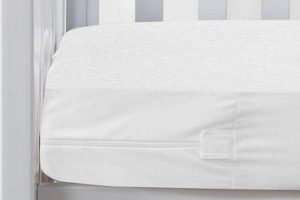
![Lullaby Earth Crib Mattress: Safe, Certified [Sleep] Organic & Natural Mattress Buyer’s Guide: Non-Toxic Sleep Solutions Lullaby Earth Crib Mattress: Safe, Certified [Sleep] | Organic & Natural Mattress Buyer’s Guide: Non-Toxic Sleep Solutions](https://mattressworldpa.com/wp-content/uploads/2025/07/th-1276-300x200.jpg)
